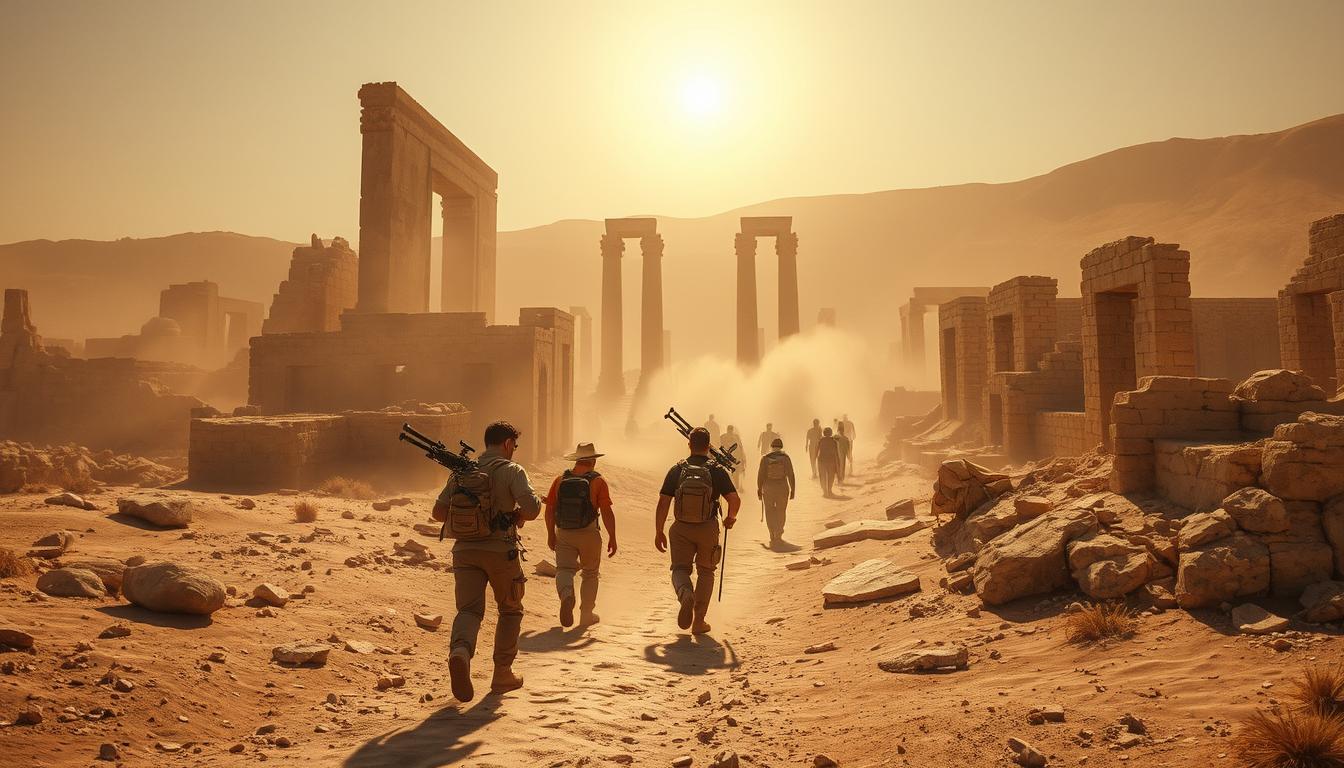Have you ever thought about walking in the footsteps of ancient people? Visiting historical landmarks lets you experience time travel like nothing else. It brings hidden stories to life. When you explore ancient ruins, you discover the secrets and wonders that shaped our world. Where will your next adventure take you on this historical journey?
Key Takeaways
- Explore how visiting ancient ruins connects us to our past.
- Discover the emotional and educational value of heritage sites.
- Learn significant historical landmarks around the world.
- Understand the role of archaeology in unearthing lost civilizations.
- Gain insights into the challenges and solutions in preserving historical sites.
- Plan your own historical journey with essential tips and resources.
- Experience virtual tours to explore ancient sites from home.
The Allure of Ancient Ruins: Why We Explore the Past
Ancient ruins pull many people into a journey through time. They connect the past and present in a unique way. By visiting these sites, you step into the story of your ancestors, feeling a deep connection across centuries.
The Emotional Connection to History
When you visit ancient ruins, you feel a strong emotional connection. You sense the presence of those who lived before you. This feeling makes you more curious and appreciative of the past.
“When you stand before the ruins, you feel a strong sense of presence and history that books alone can’t provide.”
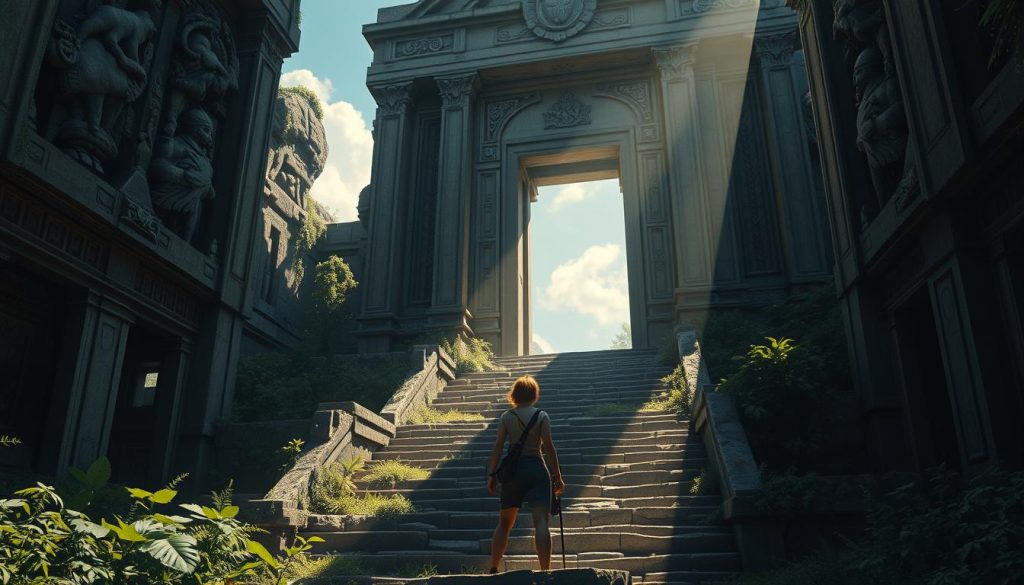
The Educational Value of Heritage Sites
Heritage sites are more than just emotional experiences. They are full of learning opportunities. These places connect you directly to historical events, making history come alive.
Exploring these sites gives you a glimpse into the past. You see and touch things that tell stories of old times. This way of learning is engaging and memorable.
Top Ancient Ruins Around the World
The world is full of ancient landmarks that tell stories of the past. Each site connects us to our shared human history. Let’s explore some of the top ancient ruins around the globe.
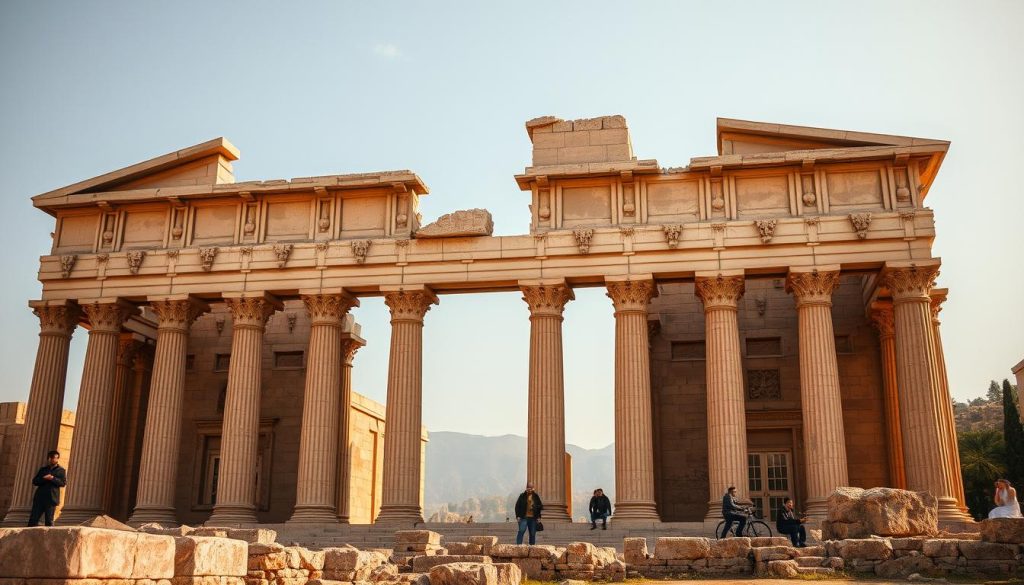
Machu Picchu: The Lost City of the Incas
Machu Picchu is hidden in the Andes mountains. It shows the Inca civilization’s amazing engineering skills. This site is known for its mix of nature and design.
Walking through, you’ll see stunning views of mountains. From the Sun Gate to the Temple of the Three Windows, it’s full of secrets from the past.
The Pyramids of Giza: Architectural Marvels
The Pyramids of Giza are symbols of ancient engineering. They were built as tombs for Egyptian kings. They line up with the stars, showing the Egyptians knew a lot about astronomy.
Visiting these sites takes you back in time. You’ll be amazed by the ancient architecture that still puzzles modern builders.
Stonehenge: A Mystical Wonder
Stonehenge is in Wiltshire, England, and it’s a mystery. This ancient monument has huge stones in a circle. People have wondered about it for centuries.
Its true purpose is still unknown, leading to many theories. Some think it was an astronomical observatory, others a place for ceremonies. Walking here, you might feel a special link to the ancient builders.
The Role of Archaeology in Understanding Ancient Sites
Exploring ancient sites is more than just an adventure. It’s a deep dive into our shared history. Through detailed historical research and advanced archaeological technology, experts have uncovered new insights into ancient civilizations.
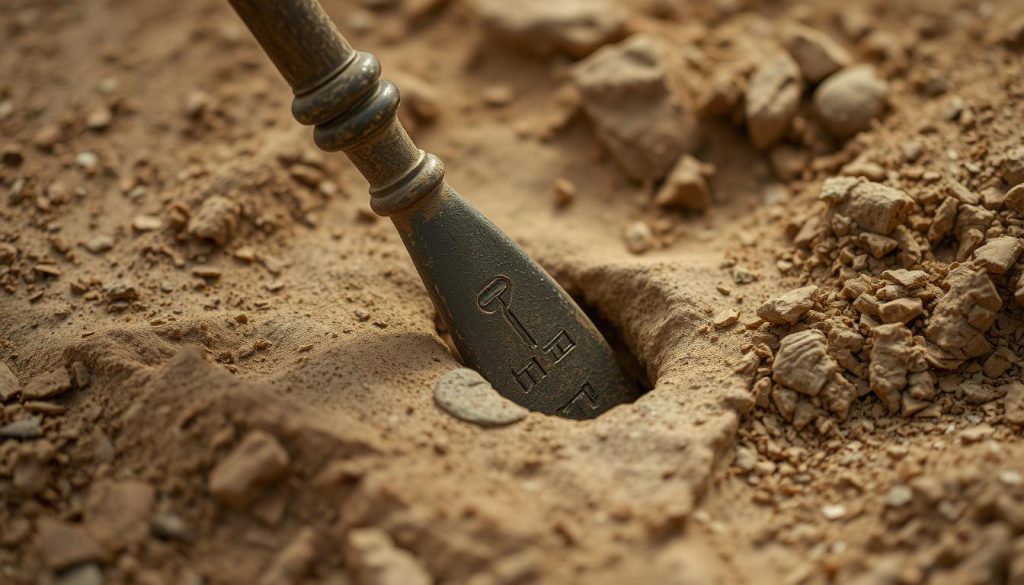
Uncovering Lost Civilizations
Archaeologists are key in uncovering and understanding ancient societies. They use careful excavation methods to piece together our past. This reveals the daily lives, religious beliefs, and social structures of long-lost cultures.
This research is crucial for understanding artifacts and ruins. It greatly expands our knowledge of human history.
Modern Techniques in Archaeological Excavations
Archaeological technology has made huge strides over the years. New tools like ground-penetrating radar and 3D imaging let us explore sites without damaging them. These technologies help archaeologists excavate with precision, protecting valuable artifacts.
By combining these new tools with traditional research, we’re learning more about ancient civilizations than ever before.
Preservation of Historical Sites: Challenges and Solutions
Keeping historical sites safe is hard work. It deals with natural decay and human actions. It’s key to know how the environment affects these sites. Climate change is a big threat, making heritage sites around the world worse.
Climate Change and Its Impact on Heritage Sites
Climate change is a big risk for historical sites. It brings sea level rise, more humidity, and extreme weather. These things make old buildings and sites wear out faster.
Venice is getting flooded more often, which threatens its buildings. The Pyramids of Giza are facing more wind erosion because of the weather changes. This shows we need to act fast.
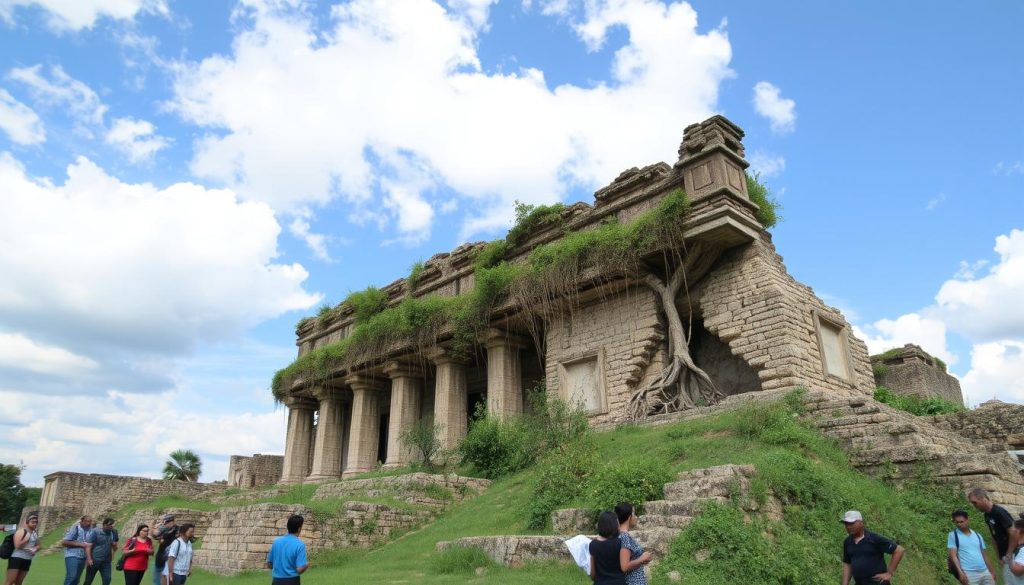
Efforts in Conservation and Restoration
Conservation and restoration efforts are key to fight against damage. They use new materials and work together across the world. UNESCO and local groups are leading the way to save these sites.
Technology is also helping a lot. For example, 3D scanning lets experts plan carefully. This way, they can fix sites without harming them. With global teamwork and new tech, we can protect these important places for the future.
Cultural Significance of Heritage Sites
Heritage sites let us see our shared cultural identity. They connect the past with today. These places, with their stunning architecture or ancient ruins, are key to keeping traditional customs alive. They also teach future generations about our history.
Connecting with Ancestral Traditions
Many heritage sites are deeply meaningful, linking us to our ancestors. They host customs, rituals, and festivals, keeping communities tied to their heritage. For example, the Great Wall of China and Mayan temples are not just historical landmarks. They are also places for rituals that have been kept alive through the years.
The Influence on Modern Culture
Heritage sites are not just about the past. They also inspire today’s culture. Artists, writers, and filmmakers often find inspiration in these places. They bring parts of these ancient wonders into modern art, literature, and movies.
This shows how these sites shape our culture today. They have a lasting effect on society.
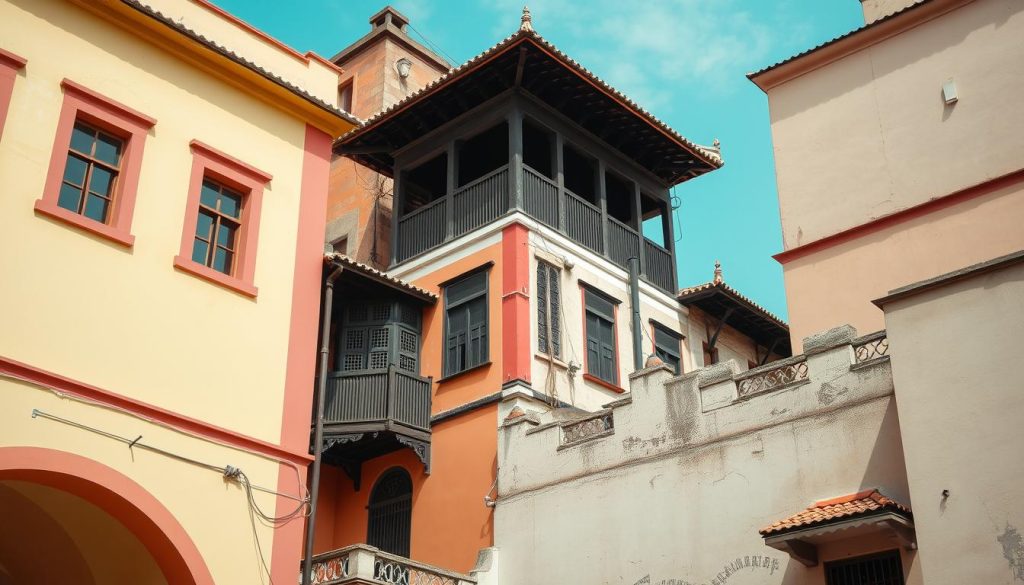
How to Plan Your Historical Journey
Going on a trip to see ancient ruins is exciting and educational. Planning well helps you enjoy your trip more. Here’s a guide to help you plan your historical adventure smoothly.
Research and Resources for Travelers
Start by researching the historical importance of the places you want to see. Use travel guides, documentaries, and academic papers to learn more. Websites like Lonely Planet and National Geographic offer great tips and insights for planning your trip. Also, check with local tourism boards for the latest on entry rules and guided tours.
Tips for a Smooth Visit to Ancient Ruins
Being prepared makes your historical visit enjoyable. Always respect the local culture and rules at the sites. Dress right, stay on paths, and don’t touch the artifacts.
Wear comfy clothes and shoes for walking or hiking. Bring water, snacks, and a first-aid kit with you.
Learning a few local phrases or getting a local guide can help with language barriers. Guides share interesting stories and insights you won’t find in books. Book your tickets early and skip the busy times to enjoy history more.
Historical Journeys: Exploring Ancient Ruins and Heritage Sites
Going on historical journeys is a mix of adventure and learning. By visiting ancient ruins, you dive deep into history. You walk in the footsteps of people from thousands of years ago at places like the Colosseum in Rome or the Acropolis in Athens.
Heritage tourism helps you grow personally. Imagine being in front of the Pyramids of Giza, feeling connected to our shared past. It shows how civilizations have changed, affecting us today and tomorrow.
Exploring ancient ruins changes how you see things. It’s not just learning history; it’s feeling connected to our ancestors’ lives and stories. These experiences make you humble and inspired, showing the strength and creativity of past cultures.
By going on heritage tours, you do more than just satisfy your curiosity. You help keep these important sites safe for the future. So, think about visiting places rich in history for a deeper journey and a better understanding of human history.
The Impact of Tourism on Heritage Sites
Tourism is key to supporting the upkeep of historical sites. But, it also brings challenges. Visitors often harm these sites, leaving a big mark. We need to find a way to keep them safe while still letting people enjoy them.
The benefits of tourism are clear, but so is the need for sustainable practices. Too many visitors can cause overcrowding. This puts a strain on ancient ruins.
It’s vital to use sustainable tourism to lessen the bad effects of more visitors. This means controlling how many people come, following strict rules, and teaching people why these sites need to be saved. By doing this, we help these amazing places last longer and make visits better for others in the future.
We aim to balance tourism with protecting history. Teaching visitors about their impact can help everyone work together to save these sites. You can still enjoy the history and beauty while thinking about how to protect it. This way, these places will be here for future generations.
Virtual Tours: Exploring Ancient Sites from Home
Today, digital tools have changed how we connect with historical sites. Now, with virtual reality, you can visit ancient ruins from your own home. This new way of experiencing history makes it easier for everyone to learn and enjoy.
Virtual tours give you a hands-on look at famous places like the Colosseum or Machu Picchu. You can walk through every nook and cranny, learning more about these amazing sites.
Thanks to advanced tech, digital tours help us care more about preserving history. They let teachers and history lovers share their knowledge with more people. This way, history reaches those who might not have been able to visit these places before.
Virtual tours also save money and are better for the planet than real travel. They encourage us to explore responsibly. This helps us value and protect our global heritage even more.
Stories and Legends Associated with Ancient Ruins
Ancient ruins are more than just old stones and buildings. They are filled with historical legends and cultural narratives passed down through time. When you visit these sites, you can imagine the stories of old. This lets you see them through the eyes of those who first told these ancient myths.
Myths Surrounding the Colosseum
The Colosseum stands as a symbol of Rome’s greatness. It has many ancient myths and historical legends around it. People say ghostly gladiators walk its halls and that the arena still echoes with old battles. When you visit, try to feel the spirit of these cultural narratives. Wonder which parts of the stories might be true.
Legends of the Mayan Temples
The Mayan temples in Central America are not just old ruins. They are full of cultural narratives. Legends tell of gods visiting these places and of civilizations vanishing. The complex paths and big pyramids seem to share secrets with anyone who listens. They invite you to explore the mysterious historical legends of the Maya.
Places like Rome’s Colosseum and the Mayan temples have historical legends and cultural narratives that make them special. These stories make every visit a trip back in time. They help us understand and value the ancient ruins more.
Conclusion
Your journey into ancient ruins and heritage sites is more than just a look back in time. We’ve seen amazing places like Machu Picchu, the Pyramids of Giza, and Stonehenge. We’ve learned how archeology helps us understand lost civilizations. And we’ve talked about why it’s crucial to protect these sites from threats like climate change.
These experiences let us connect deeply with our ancestors. Through heritage sites and their cultural importance, we see how ancient ruins are like living museums. They help us appreciate history and keep our cultural heritage alive.
When planning your cultural journey, remember to respect and protect these sites. By doing this, you help keep these treasures safe for the future. This way, the stories and lessons from our past stay alive and open to everyone. Happy travels and keep exploring!

